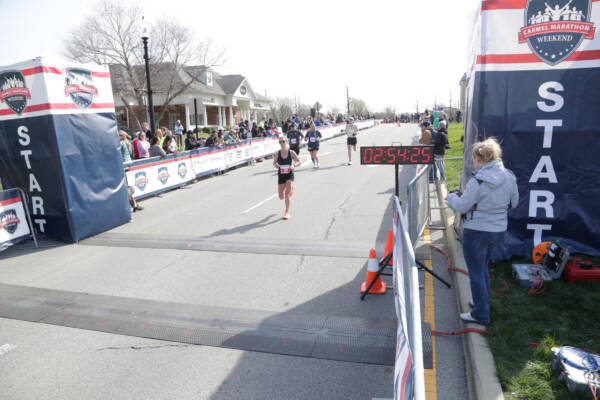9 Best Hill Workouts for Runners (+ Hill Training Guide)
(Reviewed by exercise physiologist Todd Buckingham) — As the famed running coach David Roche, author of The Happy Runner, likes to say: “Hills pay the bills!” Running hills act as a two-fer for runners—hill workouts build strength while also building endurance. Running hills can also prevent injury. A training program that includes hills can be beneficial for all levels of runners!

A lot of people don’t like running hill workouts because they are challenging. But I love them because I can feel my body getting stronger and my stride figuring out the most energy-efficient way to move. I also love that there’s no judgment in hills—you run based on effort, not pace. If it feels hard, you’re doing it right.
But hill running can also cause injury if not introduced or dosed correctly. That’s where I come in. For this article, I am going to share with you how to introduce hills into your run training to make you a better runner. Then I will share my favorite hill workouts for runners. So let’s go!
Jump Ahead
- 9 Best Hill Workouts for Runners
- 1. Power Hill Strides
- 2. Hilly Route
- 3. 200-Meter Hill Repeats
- 4. 400-Meter Hill Repeats
- 5 . Long Climb Run
- 6. Ladder Hill Workout
- 7. Hill Sandwich
- 8. Hill Crest
- 9. Todd’s Strength Hills
- Do hills make you a better runner?
- Benefits of Hill Workouts for Runners
- How should I do hill training?
- When can I run hills?
- What if I don’t have a hill to run on?
- How steep should a hill be that I run?
9 Best Hill Workouts for Runners
Below are my favorite hill workouts for my runners to help get them fitter and stronger. They are listed progressively. Feel free to make these your own as hills can be adjusted by time, reps, intensity, length, and grade (steepness).
1. Power Hill Strides
Purpose: I use these short reps of hills as a staple of my runners’ training as it helps build speed and improve neuromuscular fitness and form.
Frequency: Do this workout once a week at the end of an easy run.
- Find a moderate-grade hill that is about 50 meters long (.03)
- Run up it increasingly HARD (should take about 15-20 seconds) so that you finish near maximum effort. Because it is a short burst of work, you should not feel overly out of breath.
- Focus on good form.
- Jog down to the bottom of the hill, and fully recover.
- Repeat for a total of 4 reps.
- You can grow up to 8 reps if you need more strength in your stride after your body has adapted. Add two at a time, adjust for 2-4 weeks, add 2 more.
2. Hilly Route
Purpose: I love this hill workout as a way to introduce speed and endurance to a runner in the beginning of a training cycle. It’s unstructured which takes any pressure off and serves to wake up the body—both the muscles, tendons, ligaments, nerves, heart, and lungs!
Frequency: Do this workout once 1-4 weeks in the base phase of a training cycle. I like to program this workout throughout a training cycle, sometimes during down weeks, as a brain break for my athletes.
- Find a hilly course that has rolling hills.
- Run about 1-2 miles to warm up. Then find hills.
- Run the uphills hard and the downhills easy. How often, how long, how hard doesn’t really matter. But aim to get several minutes of work per mile.
- Flats just run at an easy pace.
- Do this for anywhere from 2-6 miles.
- Cool down 1-2 miles.
3. 200-Meter Hill Repeats
Purpose: These hill repetitions do a great job of building strength and endurance without overly taxing the body. The repeats are just long enough to start working your aerobic system but short enough that it doesn’t take long to recover.
Frequency: Do this workout once 2-4 weeks in the base phase of a training cycle. I like to sprinkle this workout in throughout a training cycle to continue to build leg strength and turnover.
- Find a 200-meter (.12) meter hill that is about 8-12 percent incline.
- Warm up for about 2 miles.
- Then run the hill hard (8/10 rate of perceived exertion) all the way to the top.
- Jog back down to recover.
- Repeat anywhere from 8-16 times based on your goals and running level.
- Cool down about 2 miles.
4. 400-Meter Hill Repeats
Purpose: These hill intervals build strength and endurance in a runner. It is challenging but because it is interval-based, it allows for mental and physical recovery in between.
Frequency: Do this workout once 2-4 weeks in the base phase of a training cycle. I like to sprinkle this workout in throughout a training cycle to continue to build leg strength and turnover.
- Find a 400-meter (.25) meter hill that is about 8-12 percent incline.
- Warm up for about 2 miles.
- Then run the hill hard (8/10 rate of perceived exertion) all the way to the top.
- Jog back down to recover.
- Repeat anywhere from 6-16 times based on your goals and running level.
- Cool down about 2 miles.
5. Long Climb Run
Purpose: Running a longer rep of hills that take you between 3 and 10 minutes to complete will help boost fatigue resistance (time to tire) and improve lactate clearance in runners. They also teach you how to run with proper form when tired, which is when a lot of us start getting sloppy.
Frequency: These workouts are tough and can be used through a training cycle about once per month.
- Find a moderate grade hill that is long (about 800 meters or longer).
- Warm-up for about 2 miles.
- Run the hill at a 5k to half marathon effort. 5k if the hill is closer to 800 meters long and half marathon if it is longer (like a mile). Pay attention to running form.
- Jog back down.
- Depending on the length of the hill, repeat 4-8 times.
- Cool down two miles.
6. Ladder Hill Workout
Purpose: This workout keeps you mentally engaged, teaches runners pacing, and also develops your neuromuscular fitness, pushes the lactate threshold, and builds strength in your lungs and legs.
Frequency: These workouts are also tough and can be used through a training cycle about once per month.
- Find a moderate grade hill that is long (about 800 meters or longer).
- Warm-up for about 2 miles.
- Do the ladder workout: 5 minutes hard, jog back down; 4 minutes hard, jog back down; 3 minutes hard jog back down; 2 minutes hard, jog back down; and then 1 minute hard, jog back down.
- Cool down two miles.
7. Hill Sandwich
Purpose: I also really love sandwiching a harder workout with hills to teach the legs how to run when they are tired.
Frequency: These workouts are challenging. Do them every 3-4 weeks, mostly in the base phase.
- Find a moderate-grade hill that is about 100 meters long.
- Warm up for about 2 miles.
- Run 4 by 100-meter repeats, running hard and then jogging back down.
- Recover and then do a 20—30 minute tempo pace run.
- Repeats the short hill repeats.
- Cool down two miles.
8. Hill Crest
Purpose: This workout builds mental strength as much as it builds muscular strength. You work hard and just when you think your hard work is over, you work even harder.
Frequency: Do this workout once 1-4 weeks in the base phase of a training cycle. You can also sprinkle this throughout the training cycle to add variety from flat running.
- Find a running course that has rolling hills.
- Run about 1-2 miles to warm up. Then find hills.
- Run the uphills hard –BUT when you get to the top of the hill, run it even harder so that you are striding on the flat surface for about 10 seconds.
- If you have a hilly race coming up, run the downhills hard. Otherwise, run them at a normal pace.
- Do this for anywhere from 2-6 miles.
- Cool down 1-2 miles.
9. Todd’s Strength Hills
Purpose: You get a lot of bang for your buck with this workout. In total, it’s only 10 minutes of running uphill, but the increased force production will create large adaptations.
Frequency: Do this workout once 1-4 weeks in the base phase of a training cycle. You can also sprinkle this throughout the training cycle to add variety from flat running.
- Warm up for at least two miles.
- Find a moderate-grade hill.
- Do 5 x 60 seconds at 10k effort, jog down the hill for recovery
- Take 2 minutes to jog on the flats at the base of your hill
- 5 x 60 seconds at 5k effort, jog down the hill for recovery
- Cool down 2 miles
FAQs about Hill Running
How do hills make you a better runner?
Yes, hills can make you a better runner because the increased power output with reduced impact which can reduce injury risk. In fact, hills are so great, I have my pregnant runners do them instead of faster workouts on flat ground.
According to exercise physiologist Todd Buckingham, there are many benefits of hill running: “Hill running workouts can be great for developing a strong aerobic engine and also building strength simultaneously. Hill runs for a runner are like increasing the weight for a weight lifter. To get stronger, you have to increase the stimulus,” Buckingham explains. “Running uphill requires greater force production and muscle fiber recruitment which will make you a stronger and faster runner.”
Benefits of Hill Workouts for Runners
- Hills build muscular strength in a similar way as strength training—but they can also give you more explosive strength
- But they also build strength in a biomechanical way that teaches your body proper running form with a forward lean, strong and efficient knee drive, and proper foot strike with a midfoot strike near your body’s center of gravity.
- They teach your muscles to clear lactic acid, pushing your lactate threshold.
- Hills boost neuromuscular fitness by engaging many muscles and teaching them how to work together efficiently.
- They also boost your VO2 Max and cardiovascular fitness.
- Hill work beats training boredom, boosts mental toughness, and teaches runners how to run by effort instead of relying on their watch.
- Hills can also prevent injury by strengthening your bones, muscles, and connective tissues while working your cardiovascular system with less impact than running on flat terrain.
And a little can go a long way with hills. Also remember, you can have too much of a good thing. Don’t read to this point and think it would be beneficial to start adding hill sprints to the end of every run. That’s a great way to get injured!
How should I do hill training?
There is a right way to introduce hills—and that is a little bit to start. You want to introduce hill training:
- After you have a solid base running for several months.
- Always do hills after a proper warm-up of at least 15 minutes of running.
- Always run hills by effort over prescribed pace.
- Start with one day a week after an easy run with about 4 short hill strides for about 50 meters.
- After 2-4weeks you can increase the hill reps or length of the hill.
- After about one month of hill strides, a runner can start doing a hill workout 1-4 times a month depending on where they are in their training cycle, and their running goals.
- If you are in the base-building phase of a training cycle, you can run hill workouts as often as one time per week (plus hill strides).
- If your goal race is going to be hilly, you’ll want to train hills more often—including with downhill running.
- Closer to the middle and end of a training cycle, sprinkle regular hill training in to maintain strength.
- Do not run hills within 3 weeks of a major long-distance race or the week of a shorter-distance yet important race.
Don’t be surprised if you are sore after running hills!
“Remember, more muscle fibers are being recruited,” notes Buckingham. “It’s also important to note that you should not perform hill workouts more than 1-2 times per week. The increased fiber recruitment and subsequent soreness after a hill workout also require an increased amount of post-workout recovery.”
When should I run hills in my training cycle?
As noted, hills belong throughout a runners’ training cycle with the exception of close to race day or during a marathon taper for marathon runners.
Hills are useful for all types of runners including sprinters, marathon runners, middle-distance runners, long-distance runners, ultra runners, and trail runners! They do an amazing job of perfecting running form, preventing injury, and building cardiovascular and muscular strength.
Hill work provides a mental break from speedwork on the road or track—and takes the pressure of trying to hit specific splits which can be anxiety-producing. Many coaches rely on hills for their runners and even place it instead of strength training.
What if I don’t have a hill to run on?
I have many athletes who live in flat areas with no hills. So we have them look for parking garages or find a treadmill to run hill workouts on. Both are great options for finding a moderate-grade hill.
How steep should a hill be that I run?
How steep your hill should be for your hill workout depends on the type of workout you are doing. In most cases, you will want a moderate grade that is about 3-7 percent grade incline. If you are looking for a steep hill to do a short hill stride, look for a hill 8+ percent in incline, says Buckingham. Don’t stress about the numbers though.
A moderate hill is a hill you can feel but it isn’t crazy hard to walk up. A steep hill is perceptible.
What is good uphill running form?
- Run tall with a forward lean into the hill—not back away from the hill.
- Pump your arms by your sides.
- Lift your knees.
- Keep your steps short and under your body.
Running downhill you:
- Run with quick light steps.
- Have a forward lean.
- Angle feet if super steep.
- Keep eyes ahead not down at your feet.
- Keep arms low and to your sides for extra balance.
If you want guidance with your running and goals, including hill training!, check out my run coaching services. Do you run hills in your training?






